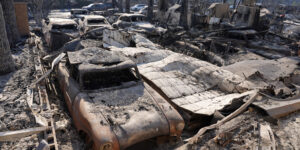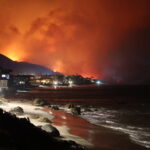The first skyscraper at lower Manhattan’s World Trade Center is set to open with two days of ceremonies to mark the renewal of the area after its destruction by terrorists. When the fanfare subsides, the task will be filling the 40 percent of the tower that’s empty.
 “We feel a real sense of accomplishment for having made it to this place,” said Janno Lieber, president of the company that built the 72-story 4 World Trade Center, opening Wednesday. It means the site is “really becoming part of New York again.”
“We feel a real sense of accomplishment for having made it to this place,” said Janno Lieber, president of the company that built the 72-story 4 World Trade Center, opening Wednesday. It means the site is “really becoming part of New York again.”
He predicts the property’s allure for companies will shine through as the construction fences come down. Lieber’s firm, a unit of developer Silverstein Properties Inc., has to fill a million square feet of offices, a space almost the size of the Chrysler Building. The only tenants at the 2.3 million-square- foot (214,000-square-meter) 4 World Trade tower are two government agencies that committed to the project in 2006 to help jump-start rebuilding at Ground Zero.
As the World Trade Center takes its first steps toward once again becoming a vibrant office district, it faces “a very competitive environment” that probably will remain for the next few years, said Michael Cohen, tri-state regional president of brokerage Colliers International. The first tower’s debut and the completion in January of 1 World Trade Center will add 2.4 million square feet of unleased space, testing a downtown market that’s already contending with more than 6 million square feet of offices left behind by shrinking financial companies.
Large Supply
“This is the thin end of the wedge of a large supply of class A space that will be accumulating in the Trade Center area,” Cohen, in an interview, said of 4 World Trade. “At the end of the day, supply and demand will determine what that space trades for. You have three of the city’s most deep-pocketed and sophisticated landlords that will be going toe-to-toe. I look forward to observing the outcome.”
Silverstein Properties, whose chairman is Larry Silverstein, is competing for tenants with Douglas Durst, who teamed with the Port Authority of New York and New Jersey to build 1 World Trade Center. About 45 percent of that skyscraper’s 3 million square feet are unspoken for. The third landlord is Brookfield Office Properties Inc., whose Brookfield Place complex just to the west has about 2.7 million square feet of former Merrill Lynch & Co. space that’s unrented.
The tenants that have committed to leases at 4 World Trade are the Port Authority, owner of the 16-acre (6.5-hectare) Ground Zero site, and New York City, which plans to move its Human Resources Administration there.
Tire-Kickers
“You hear tales of all kinds of tire-kickers, but I haven’t heard of a solid deal,” said Cohen, who isn’t involved in the leasing effort.
The job will get easier once the skyscraper opens and the public gets to see it as a vital, functioning office property, Lieber said in an interview. After tonight’s concert by the New York Philharmonic and tomorrow’s ribbon-cutting, Silverstein Properties will start a campaign aimed at would-be tenants with the theme “See4Yourself.”
More than 2,700 people died when terrorists crashed hijacked jets into each of the twin towers of the original World Trade Center in September 2001. The attacks destroyed both skyscrapers plus four nearby office buildings and a hotel. In addition to 1 and 4 World Trade Center, plans for the site call for two more office towers, a transit hub designed by Santiago Calatrava, a 9/11 museum and a performing arts center. A memorial to the victims opened in 2011.
Not Lonely
Larry Silverstein, who leased the original towers from the Port Authority just six weeks before the 9/11 attacks, said he’s confident the process will be similar to what happened at 7 World Trade Center, a 1.7 million-square-foot building north of the 16 acres that’s almost fully rented to tenants including Moody’s Corp., music-rights company BMI Inc. and Mansueto Ventures LLC, publishers of Fast Company and Inc. magazines.
When Silverstein, 82, completed that building in 2006, “we were the only tenant,” he said in an interview. “Nobody was in the building. It was very lonely, but not for long.”
Office demand in lower Manhattan—an 83 million-square- foot market—has been accelerating, data from brokerage CBRE Group Inc. show. In the third quarter, agreements were signed to rent 1.53 million square feet, up 40 percent from the previous three months and better than the five-year average of 1.04 million square feet, according to CBRE.
The availability rate as of Oct. 31 was 14.6 percent, down from an eight-year high of almost 16 percent at the end of June, the brokerage said. The rate, which measures vacant space and offices expected to be empty within 12 months, is the highest of Manhattan’s three major office markets. Asking rents averaged $46.98 a square foot, compared with $62.27 boroughwide.
Goldman Sachs
Other prominent downtown buildings with large vacancies include 180 Maiden Lane, where American International Group Inc., once the world’s largest insurer, is leaving about 800,000 square feet. Goldman Sachs Group Inc.’s former headquarters at 85 Broad St. has 637,000 square feet available, and 1 New York Plaza, once partially occupied by Goldman Sachs, has 392,000 square feet, according to brokerage Newmark Grubb Knight Frank.
Last month, JPMorgan Chase & Co. agreed to sell 1 Chase Manhattan Plaza, a 2.2 million-square-foot tower. The bank, which occupies about half of the building, intends to leave most of that space by the end of 2014, according to a person with knowledge of its plans, who asked not to be named because the information was private.
Brookfield is revamping its namesake complex, the former World Financial Center, to appeal to the city’s growing technology firms. Melissa Coley, the New York-based company’s spokeswoman, declined to comment on competition among landlords.
Tough Negotiator
Silverstein is seeking about $75 a square foot for the vacant space at 4 World Trade Center, according to two people with knowledge of his marketing plans. At that rate, a tenant would pay about $68 a square foot after tax and utility-cost breaks enacted by state in the mid-2000s to encourage leasing.
Silverstein, who also is developing two other towers at the site, is known for being a tough negotiator, said Lawrence Longua, recently retired as a clinical associate professor at New York University’s Schack Institute of Real Estate.
“He’s done this before,” Longua said in a telephone interview. “He says, ‘This is my asking rent, and if you don’t want to pay it, don’t bother talking to me.'”
The Durst Organization also is seeking $75 a square foot for the vacant areas below 1 World Trade Center’s 64th-floor skylobby, according to Eric Engelhardt, the company’s vice president for leasing. For the 104-story tower’s upper floors, it would be “pretty safe to assume” that the rate would be higher, he said. The same incentive package Silverstein is offering would apply.
‘Collaborative Competition’
Engelhardt described the two new skyscrapers as being in “a happy, collaborative competition” for tenants.
“Four World Trade’s success will only mean success of the greater good for the World Trade Center itself,” he said on Oct. 31 at the unveiling of a suite of sample office layouts on the 63rd floor of 1 World Trade.
For their money, 4 World Trade Center tenants would get offices built around a reinforced concrete core, following safety standards put in place after 9/11. New York Harbor, the Hudson River and Brooklyn and Manhattan bridges are visible from floor-to-ceiling windows.
Dignified Presence
Fumihiko Maki, the tower’s Pritzker Prize-winning architect, aimed for a “quiet, dignified” presence, out of respect for the Sept. 11 Memorial and Museum, which is across the street from the building’s entrance, according to a video on Silverstein’s website. A highly polished black wall, which reflects the trees from the memorial park, is the backdrop for the front lobby off Greenwich Street, which runs through the area for the first time since site clearing began for the original World Trade Center.
A terrace on the 57th story that offers a view of 1 World Trade Center and private outdoor space for entertaining would go to the tenant that rents the floor, said Dara McQuillan, a Silverstein spokesman.
Construction of the tower cost $1.67 billion, with about $1.2 billion of that paid for with tax-exempt Liberty Bonds. The government leases are pledged to cover debt service on those bonds. An insurance payout, which Silverstein spent almost six years litigating, covers almost all the rest of the building cost.
Insurance Payout
Much of the $4.6 billion settlement was used to pay rent to the Port Authority under Silverstein’s 99-year net lease, which continued even after the towers were destroyed. Insurance proceeds of $852 million are being split between 4 World Trade Center and 3 World Trade, according to a 2010 agreement with the agency. The base is being constructed at that planned 80-story skyscraper.
That tower, and another Silverstein is developing at 2 World Trade Center, won’t be built to their full heights until there’s enough leasing in place to make them financially viable, according to the agreement. GroupM, a division of WPP Plc, the world’s largest advertising company, is in talks to be the main tenant at 3 World Trade Center, with about 515,000 square feet of offices, two people with knowledge of the discussions said.
At 4 World Trade, the Port Authority will pay rent starting at $65 a square foot under a 30-year lease for 601,000 square feet, according to a 2011 offering memorandum for the Liberty Bonds. The agency, which built the original Trade Center complex in the 1960s, said in September that it may seek to sublease as much as a quarter of its space.
Liberty Bonds
New York City is renting 582,000 square feet starting at $56.50 a square foot. Together the city and the Port Authority will pay $65.3 million a year through 2026, equal to the debt service owed on the bonds over that time.
The last of the bonds mature in 2051. Their use will probably save Silverstein about $113 million in interest over the 40-year life of the debt, compared with what he would have paid using conventional commercial financing, according to an analysis done for Bloomberg by Evercore Wealth Management LLC, a New York-based investment bank.
Liberty Bonds, federal loans authorized by Congress after 9/11 as part of a $21 billion lower Manhattan recovery package, also were used to fund projects such as Goldman Sachs’s new headquarters at 200 West St. and 1 World Trade Center.
That skyscraper is getting ready to open in January, when the Durst Organization expects its 1.2 million-square-foot anchor tenant, Conde Nast Publications Inc., to start fitting out its space. Tara Stacom, the Cushman & Wakefield Inc. executive vice chairman who is working with Durst to market the property, has touted it as the centerpiece of site, offering tenants the “instant status” of a world-famous address.
Neither 1 nor 4 World Trade Center has an advantage, said Michael Shenot, a managing director at brokerage Jones Lang LaSalle Inc. who has done work for the Port Authority.
“They’re all wonderful products,” he said. “This is where the art of the deal, as Donald Trump once said, comes in. How do you get the prospective tenant to say yes?”
–With assistance from Dawn Kopecki in New York. Editors: Christine Maurus, Kara Wetzel





















 More Arrests Made in $8M Auto Theft Ring Bust
More Arrests Made in $8M Auto Theft Ring Bust  Los Angeles Fires Become Existential Test for California’s Stopgap Insurer
Los Angeles Fires Become Existential Test for California’s Stopgap Insurer  California Wildfires Will Likely Lead to Large Economic and Insured Losses
California Wildfires Will Likely Lead to Large Economic and Insured Losses  Why All the Fuss? Fairness Regulations Meet Insurers’ Growing Use of AI
Why All the Fuss? Fairness Regulations Meet Insurers’ Growing Use of AI 
